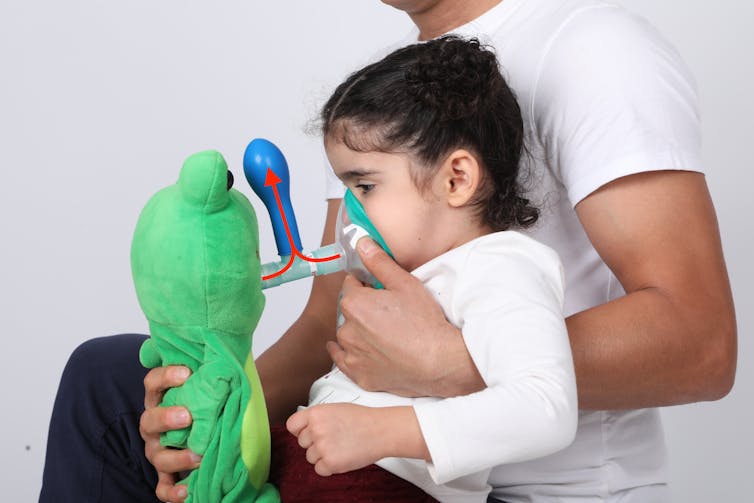Glitches in our evolutionary development mean that 80% of four-year-olds get glue ear, a temporary loss of hearing. Many have costly and unnecessary surgery despite there being excellent non-surgical alternatives.
Glue ear or secretory otitis media, to give it its medical name, is caused by a build up of fluid in the middle ear. It can affect a child’s hearing, speech, learning and behaviour.
Although glue ear usually resolves on its own, it can last for many months. During this time, most children receive no treatment and have to face the consequences of considerable hearing loss for weeks or months at an important stage of their development.
The default treatment for glue ear is grommet surgery, which is where a small tube is inserted in the eardrum to regulate the pressure in the middle ear. However, surgery is costly and not risk free. There is also a lack of good-quality evidence that surgery achieves a long-term solution to recurrent bouts of glue ear.
Evolutionary glitches
The human ear is an amazing and complex system. It has two roles, hearing and balance.
The mechanical part of hearing is related to the normal movement of the eardrum, and the three bones in our middle ear that carry the sound vibrations to the inner ear.
In the inner ear, the sound waves are transformed into electric impulses that are sent to the brain, allowing us to hear. In contrast, birds and reptiles only have one little ear bone and no empty middle ear space. The human ear evolved this middle air-filled space to provide room for the three inner ear bones, and this evolved from ancestors with a much simpler ear anatomy.
The first evolutionary glitch is the development of the Eustachian tube – which connects the middle ear to the nose and throat and thus the outside, ensuring pressure equalisation and the clearance of secretions.
The Eustachian tube is made up of cartilage surrounded by soft tissue of muscles. In children it is short, floppy, horizontal and functions poorly, leading to negative pressure in the middle ear and a build-up of fluid causing glue ear.
The maturation of the tube and its function is a gradual process during growth, which explains the high prevalence of glue ear in young children.
The second evolutionary glitch is caused by how the middle ear was created in the first place. Research in mice shows that the lining of the middle ear comes from two different types of tissues that were in the ear before the space opened: “endoderm cells” that are covered in cilia (hairs) and “neural crest” cells that are not. The lack of hairs in parts of the middle ear means they are less efficient at cleaning, leaving it susceptible to fluid accumulation and infections.
The third evolutionary glitch is related to the lack of maturity in the child’s immune system against viruses and bacteria. Young children are exposed to many infections during the first years of life, typically from two to four years. Each infection leads to excessive mucus production in the upper airways and accumulation of liquid behind the eardrum causing glue ear.
Because glue ear does spontaneously fix itself – most countries’ clinical guidelines recommend waiting three months before any intervention. The most common form of intervention after this period is grommet surgery.
A review of studies conducted in 2010 suggests that there are initial benefits from surgery, but this diminishes after six to nine months, with no overall improvement seen at 12 to 18 months.
Long-term follow-up studies after grommet insertion show a high rate of recurrence of glue ear, increased risk of a permanently perforated eardrum, and a high chance of hearing loss in the higher frequencies in later life.
Auto-inflation
There are, of course, alternatives to surgery, such as auto-inflation.
Auto-inflation dates back to the 17th century when Italian anatomist Antonio Valsalva described the Eustachian tube and the act of holding the nose and mouth closed and forcing air into the middle ear to remove negative pressure in the ear – something that adults do when flying or diving.
Several auto-inflation devices to treat glue ear in children were developed including the nasal balloon, first introduced in 1968 by Professor Hunt-Williams. All the devices focused on autoinflation by nose, which is efficient in adults but difficult to perform in children. So there is no consensus about the effectiveness of auto-inflation, and grommet surgery remains the most common surgery performed on children.
The new generation of devices have a face mask that is used to cover the nose and mouth of a child. The mask is connected to a tube with a balloon on one end and a one-way valve on the other that allows air to enter.
The child can breathe in without resistance and every time they breathe out it inflates the balloon a little bit more, increasing the pressure and helping to open the Eustachian tube to balance the pressure and help ventilate the fluid out of the middle ear.

The new generation devices, which look like a toy, allow children as young as one year to be treated for chronic glue ear, with up to 80% of patients getting significant relief from the symptoms.
The success rate is related to using the mouth for auto-inflation instead of the nose, which was the only described method previously, and by creating auto-inflation games adapted to the age and collaboration of the child to make it fun. Adding a pump also allows for gradual pressure increase without the active collaboration of the child.
The golden rule in medicine is that surgery should be the last resort, but in the case of glue ear, it seems to be the default. We need a change in medical culture, and the question should always be: is there a better, less invasive procedure we can use?

